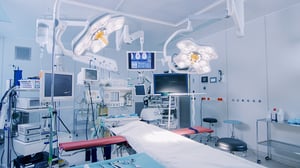How Distractions in the OR Can Increase the Risk of Errors
The operating room is rarely the quiet, clutter-free space it was in previous decades. Sixty years ago, you could hear a pin drop in the OR, but today you’d be lucky to hear your own voice over all the beeping, whirring and background noise. Veteran doctors can remember a time before the noise, but for younger healthcare professionals, it’s the only environment they’ve ever known. 
Modern technology has equipped physicians with all sorts of tools and machines designed to better monitor patients and improve outcomes — but all these gadgets come with a challenging side effect: disruption.
How much do OR noises affect care a team’s concentration and cognitive processing and what can be done about it?
Here’s what you need to know.
Studies Show Noise Pollution in the OR is Hazardous
Over the past few years, several studies have examined distractions in the operating room and how they impact patients.
Recently, doctoral student Suzan Ayas, MASc, from St. Michael’s Hospital, Toronto, studied 60 video recordings of laparoscopic Roux-en-Y gastric bypass (LRYGB) surgeries. She discovered that distractions, such as clinical alarms and other events that break surgeons’ attention, occur at a rate of about 48 per hour, according to MedPage Today.
Moreover, Ayas found machine alarms increased the risk of intraprocedural issues by more than 50%.
And according to a report by The Joint Commission, “Within an OR, noise levels have been associated with ineffective communication, diminished signal and speech intelligibility, poor performance of complex tasks, poor cognitive function and concentration (slower time-to-task completion), stress, fatigue and anxiety.”
A laboratory study published by Anesthesiology in 2014 found OR background noise contributed to a 17% reduction of anesthesia residents’ accuracy in detecting changes in the saturation on a pulse oximeter.
So, what can be done?
3 Interventions You Can Take to Reduce the Risk of Errors
Despite the disturbances and frustration alarms may cause, these machines and notifications exist for a reason. But there are a few things you can do to help reduce distractions:
- Create a “sterile cockpit” checklist
Before take-off, flight crews follow something called the sterile cockpit protocol, which is designed to eliminate anything from an aircraft cockpit that might distract the flight crew from their duties — especially during crucial moments (like take-off and landing). Consider preparing your own checklist to ensure the OR is as distraction-free as possible. Such as silencing non-critical notifications from handheld devices, like smartphones and pagers.
- Consider sending certain alarms through headsets
Surgeons don’t need to hear every beep or potential alarm. Consider directing a few of these to headsets worn by other members of the patient care team so physicians can enjoy fewer disruptive noises. - Prepare for critical moments
Some events, like initiating a cardiopulmonary bypass or clipping an intracranial aneurysm, carry higher risks than others. Because you typically know when these events will happen, it’s a good idea to prepare for them by silencing any unnecessary sounds (like music or non-essential monitors) and preventing traffic in and out of the room during these times.
Operating rooms will never be totally silent, and many of the machines that can cause disruptions also exist to help save lives. In many ways, distractions (and learning to focus despite them) are part of the surgical profession. But, by taking steps to eliminate unnecessary sounds, especially before crucial moments, can help improve concentration and reduce the risk of an error.




